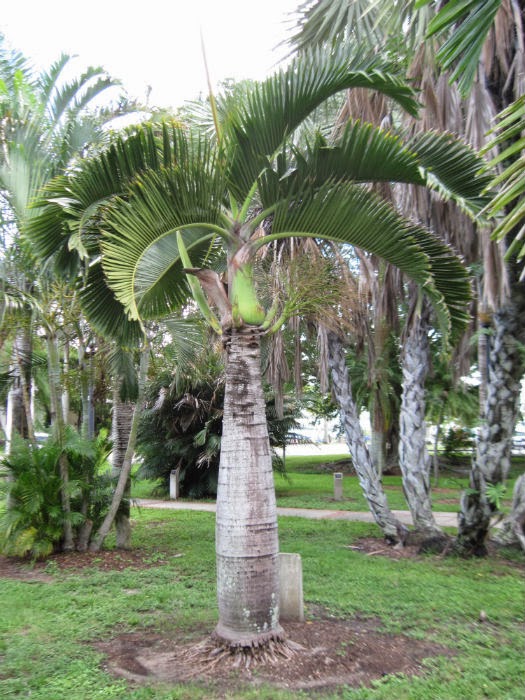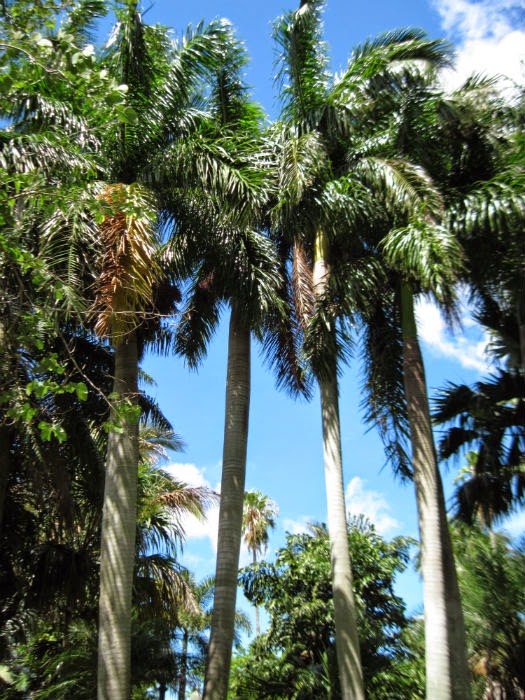Last time we explored the Park of Palms in downtown Fort
Myers, Florida, in Park of Palms: Part I. There are at least 37 palms and many
are familiar landscaping palms, like this Washingtonian palm. Though it isn’t
as common here as in Southern California.
Washingtonian Palm
European Fan Palm
This fan palm, also known scientifically as Chamaerops
humilis, is a very popular landscape palm due to its cold tolerance down to USDA
hardiness zone 7b. Its short height, at about 10 feet, makes it a good
landscape feature.
Spindle Palm
This palm, Hyophorbe verschaffeltii, is a common landscape
palm. Considered a self-cleaning palm, due to fronds that easily tear off
creating a smooth grey trunk, they grow up to 20 feet tall. They swell at the center
of their trunk similar to the bottle palm. They have beautiful pinnate, or
feather-like, v-shaped fronds that get up to 10 feet wide. This palm had two inflorescences, with small cream-colored flowers.
Majesty Palm
A common houseplant, Ravenea rivularis, is a shade tolerant
palm. They grow quickly to 10 feet and get as high as 20 feet tall. When low to the ground their crowns are more uniform, but seem to diverge with height. The trunk also swells toward the bottom.
Betelnut Palm
The betelnut palm, Areca catechu, is native to India, SE
Asia and Malaysia. It’s a relative to the coconut palm or Cocos nucifera. This
palm is less tolerant of cooler climates. The common name, betelnut, comes from
the piper betle, a mint tasting leaf, that inhabitants chew in conjunction with the nut
produced by the betelnut palm.
The following palms are some that I’ve never seen before and
certainly aren't common to SW Florida in my limited experience.
Yellow Latan Palm
This palm, Latania verschaffeltii, comes from the Mascarene
Islands off the coast of Madagascar in the Indian Ocean. This is a small
specimen, but they seem to get up to 20 feet tall. They are used as an
ornamental, but their habitat is threatened and they are considered endangered.
Talipot Palm
Corypha umbraculifera, this magnificent palm is one of the
largest in the world. It is originally from India and can grow to 100 feet with
a trunk over three feet in diameter. The palmate fronds, fan-like, grow up to
21 feet across and a single palm tree may have 130 leaflets. This specimen stands about
30 feet tall with hardly a trunk.
Silver Queen
Its scientific name is Syagrus sp. and it has the look of a
queen palm. Its name comes from the whitish cast under the fronds on mature
plants that reflect silver in the sun. It originates in Brazil and gets to 40
feet tall and has a cold tolerance down to 15 degrees F. Its position in the
park made it difficult to get a good close shot of the crown.
Gingerbread Palm
Also known as doum palm and scientifically as Hyphaene
thebaica. A native to North Africa, it grows up to 56 feet high with palmate
leaves up to 70 inches wide. It produces an edible fruit (see below) with one
seed.
Lady Palm
Also known as Rhapis Palm and scientifically as Rhapis
excelsa. This palm tree can tolerate most environments, dry, wet, indoors and
outdoors. The palm grows through underground rhizomes, spreading as wide as it
is high. It grows to a maximum height of five to 10 feet and one to five feet
wide.
Next time, join me for more exotic palms in Park of Palms: Part III.













































